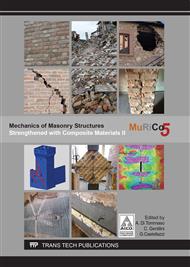[1]
Lourenço P.B., Mendes N., Ramos L.F., Oliveira D.V. (2011). Analysis of masonry structures without box behavior, International Journal of Architectural Heritage, 5 (4-5): 369–382.
DOI: 10.1080/15583058.2010.528824
Google Scholar
[2]
Bhattacharya S., Nayak S., Dutta S. (2014). A critical review of retrofitting methods for unreinforced masonry structures, International Journal of Disaster Risk Reduction, 7: 51–67.
DOI: 10.1016/j.ijdrr.2013.12.004
Google Scholar
[3]
NIKER (2012).
Google Scholar
[4]
Arifpovic F., Nielsen MP. (2006). Strength of anchors in masonry. Department of Civil Engineering, Technical University of Denmark, Rapport BYG DTU No. R-134, ISSN 1601-2917, ISBN 87-7877-205-2.
Google Scholar
[5]
Algeri C., Poverello E., Plizzari G., Giuriani E., (2010). Experimental study on the injected anchors behaviour on historical masonry, Adv. Mater. Res. 133–134: 423–428.
DOI: 10.4028/www.scientific.net/amr.133-134.423
Google Scholar
[6]
Paganoni S., D'Ayala D. (2014). Testing and design procedure for corner connections of masonry heritage buildings strengthened by metallic grouted anchors, Engineering Structures; 70: 278–293.
DOI: 10.1016/j.engstruct.2014.03.014
Google Scholar
[7]
Araujo A., Oliveira V., Lourenco P.B. (2014). Experimental behavior of masonry wall-to-timber elements connections strengthened with injection anchors, Engineering Structures, 81: 98-109.
DOI: 10.1016/j.engstruct.2014.09.034
Google Scholar
[8]
Panizza M., Girardello P., Garbin E., Valluzzi M.R., Cardani G., Dalla Benetta M., Casadei P. (2015). On-site pull-out tests of steel anchor spikes applied to brickwork masonry, Key Engineering Materials, 624: 266-274.
DOI: 10.4028/www.scientific.net/kem.624.266
Google Scholar
[9]
ACI 318 (2011). Building code requirements for structural concrete (ACI 318-11) and commentary.
DOI: 10.1061/(asce)1076-0431(1996)2:3(120.3)
Google Scholar
[10]
fib Bulletin 58. (2011). Design of anchorages in concrete: guide to good practice, fib, Special Activity Group 4, Fastenings to structural concrete and masonry structures. 978-2-88394-098-7.
Google Scholar
[11]
Gigla B., Wenzel F. (2000). Design recommendations for injection anchors as supplementary reinforcement of historic masonry, Proc. of 12th Int. brick/block masonry conference, Madrid, Spain, 25-28 June 2000: 691–706.
DOI: 10.1201/b21889-257
Google Scholar
[12]
Araujo A., Oliveira V., Lourenco P.B. (2014). Numerical study on the performance of improved masonry-to-timber connections in traditional masonry buildings, Engineering Structures, 80: 501–513.
DOI: 10.1016/j.engstruct.2014.09.027
Google Scholar
[13]
EN 1015-11 (2006). Methods of Test for Mortar for Masonry – Part 11: Determination of Flexural and Compressive Strength of Hardened Mortar.
DOI: 10.3403/01905442
Google Scholar


